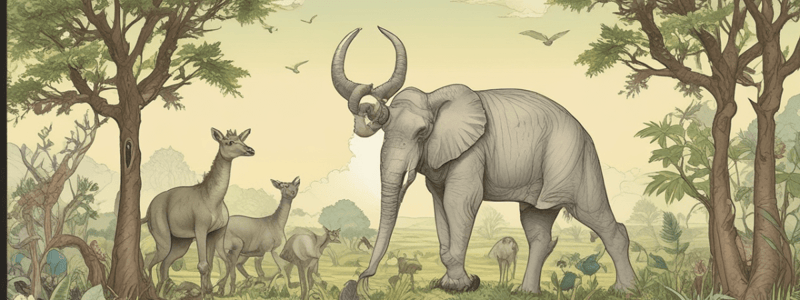Podcast
Questions and Answers
What is the primary reason why maintaining biodiversity is crucial?
What is the primary reason why maintaining biodiversity is crucial?
- To protect endangered species
- To promote ecosystem disruption
- To ensure human well-being
- To preserve ecosystem health (correct)
What is the final stage of community succession characterized by?
What is the final stage of community succession characterized by?
- A diverse community composition
- A stable community composition (correct)
- A uniform community composition
- A dynamic community composition
What is the process by which groups of individuals with certain traits are more likely to survive and reproduce?
What is the process by which groups of individuals with certain traits are more likely to survive and reproduce?
- Natural selection
- Group selection (correct)
- Species selection
- Artificial selection
What is the result of human ecosystem development in terms of biodiversity?
What is the result of human ecosystem development in terms of biodiversity?
What is a conservation strategy that involves protecting and reintroducing species?
What is a conservation strategy that involves protecting and reintroducing species?
What type of adaptation involves changes in physical traits, such as the development of wings in birds?
What type of adaptation involves changes in physical traits, such as the development of wings in birds?
What component of a niche refers to the physical environment in which a species lives?
What component of a niche refers to the physical environment in which a species lives?
Which type of ecosystem service involves the provision of food, water, and other resources?
Which type of ecosystem service involves the provision of food, water, and other resources?
What type of succession occurs after a disturbance, such as a forest fire?
What type of succession occurs after a disturbance, such as a forest fire?
What term refers to the unique role and position of a species within its environment?
What term refers to the unique role and position of a species within its environment?
Flashcards are hidden until you start studying
Study Notes
Biodiversity Conservation
- Biodiversity is crucial for ecosystem health and human well-being.
- Threats to biodiversity include habitat destruction and fragmentation, overexploitation of resources, climate change, and invasive species.
- Conservation strategies involve habitat preservation and restoration, species protection and reintroduction, and sustainable resource management.
Classification of Climax
- Climax is the final stage of community succession, characterized by a stable community composition.
- Types of climax include monoclimax, polyclimax, and climax complex.
Group Selection
- Group selection is the process by which groups of individuals with certain traits are more likely to survive and reproduce, leading to the evolution of those traits.
- Altruistic traits that benefit the group as a whole can evolve through group selection.
Development of the Human Ecosystem
- Human ecosystem development involves the modification and management of environments to create complex ecosystems.
- Stages of human ecosystem development include hunting and gathering, agriculture, urbanization, and industrialization.
- Impacts of human ecosystem development include environmental degradation, resource depletion, loss of biodiversity, and climate change.
Species Adaptation
- Species adaptation is the process by which a species becomes better suited to its environment through genetic changes.
- Types of adaptation include structural adaptation (e.g., development of wings in birds), physiological adaptation (e.g., development of camel's hump to store water), and behavioral adaptation (e.g., hibernation in bears).
Ecological Niche
- Ecological niche refers to the unique role and position of a species within its environment.
- Components of a niche include habitat, diet, and behavior.
- Types of niches include fundamental niche and realized niche.
Ecosystem Services
- Ecosystem services refer to the benefits that humans derive from functioning ecosystems.
- Types of ecosystem services include provisioning services (e.g., food, water), regulating services (e.g., climate regulation), cultural services (e.g., recreational benefits), and supporting services (e.g., soil health maintenance).
Community Succession
- Community succession is the process of change in the species composition of a biological community over time.
- Types of succession include primary succession (e.g., colonization of a new area) and secondary succession (e.g., recolonization of an area after a disturbance).
- Factors influencing succession include environmental factors (e.g., climate, soil) and biological factors (e.g., competition, predation).
Studying That Suits You
Use AI to generate personalized quizzes and flashcards to suit your learning preferences.




